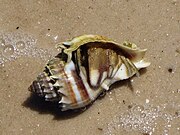
The knobbed whelk is a species of very large predatory sea snail, or in the US, a whelk, a marine gastropod mollusk in the family Busyconidae, the busycon whelks.

The Scotch bonnet is a medium-sized to large species of sea snail, a marine gastropod mollusk in the subfamily Cassinae, the helmet shells and bonnet shells. The common name "Scotch bonnet" alludes to the general outline and color pattern of the shell, which vaguely resemble a tam o' shanter, a traditional Scottish bonnet or cap. The shell is egg-shaped and fairly large, 2 to 4 inches in maximum dimension, with a regular pattern of yellow, orange or brown squarish spots. The surface sculpture of the shell is highly variable: the surface can be smooth and polished, have grooves, be granulated, or even be nodulose on the shoulder of the whorls.

Melongena is a genus of sea snails, marine gastropod mollusks in the family Melongenidae, the crown conches and their allies.

Pugilina is a genus of large sea snails, marine gastropod mollusks in the family Melongenidae, the crown conches and their allies.

Fasciolaria tulipa, common name the true tulip, is a species of large sea snail, a marine gastropod mollusk in the family Fasciolariidae. This fiercely predatory species occupies a wide geographic area within the Western Atlantic and is known, along with the other Fasciolariids, for the superficial resemblance their shells possess to a closed tulip flower.

Stramonita haemastoma, common name the red-mouthed rock shell or the Florida dog winkle, is a species of predatory sea snail, a marine gastropod mollusc in the family Muricidae, the rock snails.

Turbinella angulata, common name the West Indian chank shell or Lamp Shell, is a species of very large tropical sea snail with a gill and an operculum, a marine gastropod mollusk in the family Turbinellidae.

Volema pyrum is a species of sea snail, a marine gastropod mollusk in the family Melongenidae, the crown conches and their allies.

Cinctura hunteria, the northern banded tulip, is a species of sea snail, a marine gastropod mollusk in the family Fasciolariidae, the spindle snails, the tulip snails and their allies.

Lithopoma caelatum, common name the carved star shell, is a species of sea snail, a marine gastropod mollusk in the family Turbinidae, the turban snails.

Turbo militaris, common name the military turban, is a species of sea snail, marine gastropod mollusk in the family Turbinidae.

Turbo castanea, common names chestnut turban, chestnut turban snail-brown and cat eye snail, is a species of sea snail, marine gastropod mollusk in the family Turbinidae.

Calliostoma jujubinum, common name the jujube top shell, is a species of sea snail, a marine gastropod mollusk in the family Calliostomatidae.

Muricanthus radix, the radix murex or root murex, is a species of sea snail, a marine gastropod mollusk in the family Muricidae, the murex snails or rock snails.

Macrostrombus costatus, formerly known as Strombus costatus and Lobatus costatus, or commonly known as the milk conch, is a species of large sea snail, a marine gastropod mollusk in the family Strombidae, the true conchs. They are an edible species and important food source for the inhabitants of where they are found. Conchs are most notable for their medium to large-sized ornamental shells. Milk conchs are dispersed among the tropical waters of the Atlantic Ocean, along the coasts and islands of North, Central, and South America.
Turbo canaliculatus, common name the channeled turban, is a species of large sea snail, a marine gastropod mollusk in the family Turbinidae, the turban snails.

Volegalea cochlidium, common name the spiral melongena, is a species of large sea snail, a marine gastropod mollusk in the family Melongenidae, the crown conches and their allies.

Melongena patula, common name Pacific crown conch, is a species of large sea snail, a marine gastropod mollusk in the family Melongenidae.

Natica marochiensis is a species of predatory sea snail, a marine gastropod mollusk in the family Naticidae, the moon snails.
Brunneifusus ternatanus, common name ternate false fusus, is a species of sea snails, marine gastropod molluscs in the family Melongenidae, the crown conches and their allies.





















